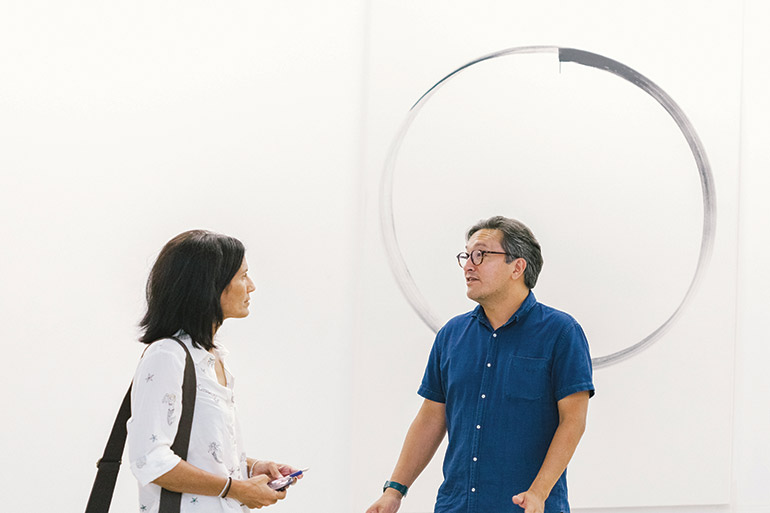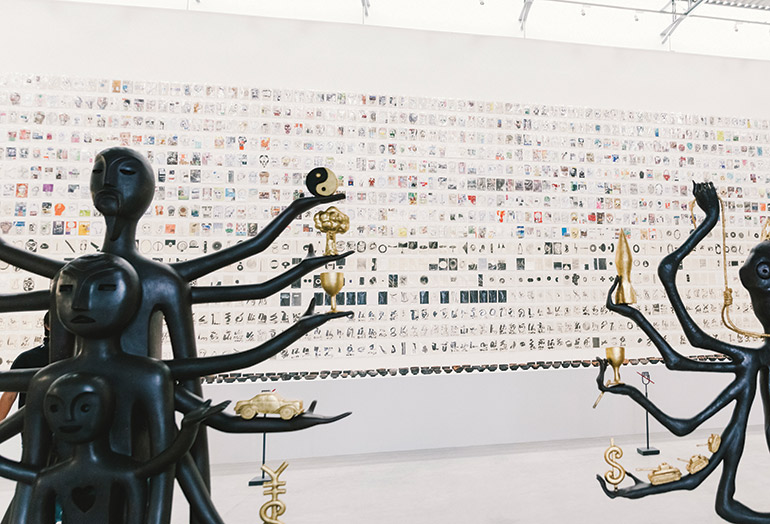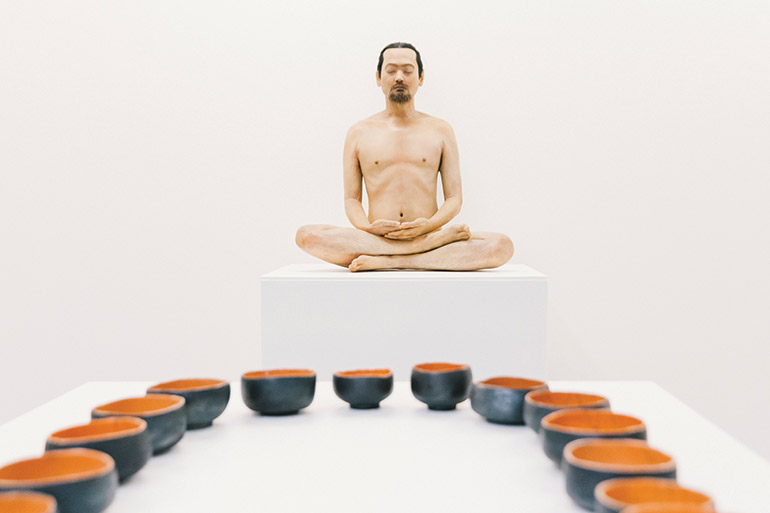In July 2016, Thai businessman Eric Bunnag Booth unveiled MAIIAM, a visually striking contemporary art museum in the northern Thai city of Chiang Mai with grand visions to fuel a healthy market of art collectors in the country. We meet with the 47-year-old marketing whizz and art collector to find out how he is applying the lessons he learned in the stock market and the textile trade to the simmering – and often unpredictable – art world

Photography by Pannawat Muangmoon
Even from a distance, MAIIAM is an arresting piece of architecture. It is located along a 3km corridor commonly known as the ‘handicraft highway’ in Chiang Mai’s San Khampeng district, 7km south of the old city centre. Next to the museum, small to medium factories, trendy artisan showrooms and busy noodle stands sit side by side while emerald green rice fields stretch towards the horizon. A converted warehouse, MAIIAM is fronted by an eye-catching, curved glass façade –designed by the hip Bangkok architectural firm all(zone) – that has become a shimmering focal point for museum goers, locals and anyone who ventures by.
It always seemed a bit strange to me that to learn about Thai modern art, you have to go to Singapore, where they’ve collected and displayed Southeast Asian art for decades
Recently, I met MAIIAM’s co-founder Eric Bunnag Booth at Khampeng Kaew, the museum’s stylish café, where, after a private tour of the 3,000-square-metre museum, we sat down to chat about his perspectives on why investors should be paying attention to Thailand’s burgeoning art market.
Before getting started, Booth ordered us each a cocktail aptly named ‘Night At The Museum’, a generous shot of dry gin spiked with a passion fruit and lime syrup. “It could be a little stronger,” said Booth after the first sip, a telltale sign of the entrepreneur’s penchant for the bold and irreverent. Booth has been collecting contemporary Thai art since the early 1990s, when he stumbled across the work of Montien Bounma, a Chiang Mai-based artist who was breaking away from the country’s classic representational art and experimenting with new materials. Over the next two decades, Booth and his family amassed a formidable collection, including the internationally recognised Rirkrit Tiravanija, Kamin Lertchaiprasert and Thawan Duchanee and regional big names, like the Cambodian-American sensation Anida Yoeu Ali. With more than 400 works to show and display, Booth and his stepfather Jean Michel Beurdeley (who he founded MAIIAM with) felt a private museum could fill a gap and help propel the country’s art market to the next level.
“Up until now, there were no places to view a permanent collection of Thai contemporary art,” explained Booth. “It always seemed a bit strange to me that to learn about Thai contemporary art, you have to go to Singapore, where they’ve collected and displayed Southeast Asian art for decades.”

“MAIIAM’s permanent collection is strictly our point of view. We are not attempting to catalogue the entire evolution of contemporary art in Thailand,” he asserted. “We started things off with exhibiting two big names [the Cannes-winning filmmaker Apichatpong Weerasethakul and acclaimed video artist Kamin Lertchaiprasert], but moving forward we want to showcase new voices and host young guest curators.”
Funded exclusively by Booth and his family, MAIIAM is a private museum and operates much like a small business with multiple revenue streams. Ticket sales, a retail shop and the café are expected to fully finance all operational costs, and so far, Booth states they have been on target. Even though the museum provides a public service, stated Booth: “we receive no tax breaks or advantages like other similar projects abroad”.
Booth is perhaps best known in his role as assistant managing director of the Jim Thompson Group, an iconic Thai silk brand that generates $100m per year in group revenues. Booth is part of the third-generation management of the company set up by Jim Thompson in 1951. His father, William Booth, started working with Thompson in 1963 and is now managing director of the company. When Eric Booth joined his father nearly 20 years ago, he quickly set about revitalising the company as a sophisticated, modern lifestyle brand. In 2003, Booth was instrumental in establishing the Jim Thompson Art Centre, adjacent to the Jim Thompson House in Bangkok’s Pathumwani district. A project of The Jim Thompson Foundation, the Art Centre has exhibited everything from textiles to cutting-edge art shows featuring local and international artists. It soon attracted a strong local following: “Ironically, we introduced a whole new generation to Jim Thompson, and the exhibits keep bringing them back,” Booth said.
An art market invariably rises when there is enough wealth and sufficient artwork within an economy. The value of a piece fluctuates over time, and with ongoing sales, re-sales, auctions and high-profile shows such as Art Basel and the Venice Biennale, pieces of art have the potential to generate their own capital gains.
With social media, visitation and conversations about us skyrocketed. Ten years ago, we would have had to wait three years to get mentioned in a guidebook
This year during the Hong Kong Spring auctions, Sotheby’s generated HK$3.1 billion, a 17% increase on the previous year. Chinese modern artworks were among the highest performers, and the Chinese government continues to underwrite museums and show their work abroad.
According to Kim Chuan Mok, Sotheby’s head of modern and contemporary Southeast Asian art, interest and sales in the region’s modern art have also grown steadily. “In 2014 and 2015, the yearly totals equalled HK$350m and HK$349m, respectively. Blue chip, fresh and rare works by established modern and contemporary artists were especially sought after,” said Mok. He added that while Thailand underperforms compared with other countries, there is growing interest among collectors for emerging Thai artists.
Booth agreed that the Thai market has vast potential, but that it needs investment. “The public sector is not doing much to support Thai artists at big international shows, so it falls on the private sector.”
In 2003, Thailand poured money into an initiative called ‘the creative economy’ and helped jumpstart Thai designers to reach a global marketplace. But contemporary artists lack this kind of backing.

“We have a handful of collectors [in Thailand], the wealth is here but the tradition of collecting is not strong,” said Booth. Things are changing, however. These days, Bangkok’s ‘hi-so’ entourage [an armada of cashed-up 20- and 30-something-year-old millennials] are snapping up modern, progressive pieces of art. “Back in my day, it used to be a Ferrari or a [Birkin] Kelly bag, but these days it is art, which is a great!”
MAIIAM’s attendance records support this claim, where 90% of visitors are between 25 and 35 years of age. “I’m really happy to see these numbers,” stated Booth, adding that the younger audience galvanised support through social media. “I’ve never fully witnessed the power of social media until now. With social media, visitation and conversations about us skyrocketed. Ten years ago, we would have had to wait three years to get mentioned in a guidebook.”
Unlike Singapore and Hong Kong, where museums, galleries, creators and collectors support a thriving market for art collectors and investors, Thailand’s modern art market is still in its early stages of development.
Thailand also lags behind the Philippines and Indonesia, where the contemporary art market is bustling. “There is a precedent for collecting in the Philippines and Indonesia,” stated Booth. “The Dutch and the Spanish influence is quite strong. Art schools there too enjoy a relationship with European schools where there is experimentation and freedom of thought.”
“In Bangkok, there are as many galleries opening as there are closing,” Booth lamented, adding that without a robust community of galleries to market contemporary art and artists, and without enough buyers, the art market will languish. “Things have changed a lot [in Thailand] in the last ten years, but we are still playing catch up.”


